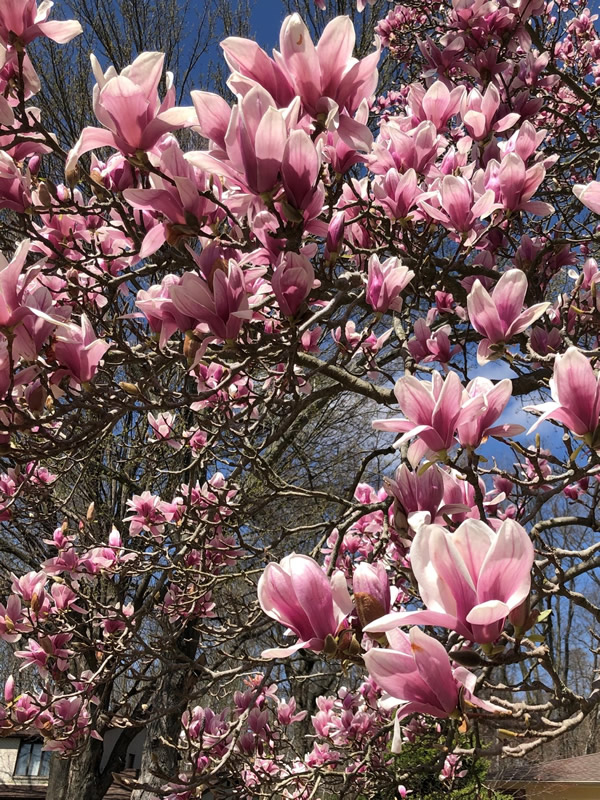Issue 1, April 20, 2020
When the Magnolia Blooms: Using the Saucer Magnolia as an Indicator Plant
When it comes to managing pests, woody plant professionals know that spraying at the optimal time will make applications more successful. Don Orton, the author of Coincide: The Orton System of Pest and Disease Management, taught us how to use phenology, i.e., the stages of plant development (usually bloom time) to predict stages in pest development and susceptibility to controls. The full bloom of the Saucer Magnolia (Magnolia x soulangeana) coincides with the emergence of spruce spider mites, Zimmerman pine moth caterpillars and eastern tent caterpillars. It is also the time those insects are the most susceptible to chemical control.

Saucer Magnoia
Spruce spider mites feed on many needled evergreens despite their name. These include junipers, pines, Douglas fir, Fraser Fir, and larch. Stippling on the needles, browning, webbing, and even mites can be detected visually in larger populations. They begin to feed on the needles and are most active in the early spring, when the magnolias bloom. They spend the summer as eggs and when the weather cools in the fall they hatch again. Several YouTube videos demonstrate scouting for spruce spider mites by shaking the older portion of the tree limbs over a piece of white paper and smashing them. The streaks of color left behind let you know what these mites are eating. Those making greenish streaks are usually spider mites that are feeding on the foliage; those making yellow-orange streaks are usually predaceous mites that are feeding on the spider mites. When predaceous mites are present, a chemical control usually is not needed. However, the tree should be monitored for increase in population. A physical control option would be to do a hard water spray on the foliage knocking them off the plant. If a pesticide is needed, miticides and insecticidal soap can provide some quick knockdown.
Zimmerman pine moth caterpillars emerge from their protective hibernaculum, winter home, and begin to bore into pine trees, particularly Scots and Austrian. As they feed on the phloem, they push out frass and sap, creating the characteristic pitch that flows from the wounds in the tree and drip down the trunk. These entry holes are usually at the junction of the branch and trunk. Broken branches and branch dieback in the upper portion of the tree are indicators there may be feeding underneath the bark. In July and August, the adults emerge and begin to lay many eggs. These eggs hatch shortly after. A physical control option would be pruning out damaged branches or removal of entire tree. Removal may be necessary if there are many susceptible trees are in the same area. If a pesticide is needed, permethrin or other chemistries can be sprayed on the surface of the trunk or branches in the spring, when magnolias bloom, and again in mid-August, when the goldenrod blooms, to control the newly hatched larvae on the surface of the bark.
Eastern tent caterpillars are a problem on some stressed trees and can cause defoliation. Larvae begin to hatch from overwintering egg masses. These egg masses are about ½ inch long, reddish brown and contain hundreds of eggs. The female moth chooses branches that are pencil-sized. After hatch, the larvae begin to make communal tents in the crotch angel of the tree. They leave the tent throughout the day and feed on leaves and as they grow bigger so does the tent. When they are fully grown caterpillars, they find a protected location and pupate. Adult moths emerge two weeks later and begin to lay egg masses. A mechanical control option is tearing open the tents to allow for predation. If a pesticide is needed, spray with Bacillus thuringiensis kurstaki, spinosad, neem oil or permethrin.
Using phenology cues, such as blooming in woody plants like magnolia, to time pesticide applications, enables you to gain the best control of the populations of these potentially devastating pests.
Author:
Kelly Allsup